Micromobility is here to stay, and it’s changing how we experience urban life for the better. With Unagi’s membership program, you can enjoy all the benefits of a top-tier electric scooter without the sky-high price of ownership or the inconvenience of ride-sharing.
San Francisco, a city known for its progressive stance on sustainability and reducing car dependency, has embraced lightweight electric scooters as a viable alternative transportation method.
The city's campaign, "Leave the Car, It's Not That Far," is a testament to the city's commitment to this initiative, actively encouraging San Francisco residents and visitors to opt for eco-friendly options like scooter-sharing services, biking, walking, or public transit, especially for short distances and in congested downtown areas.
A pioneer in electric scooter sharing
San Francisco's early adoption of electric scooters has made it one of the most scooter-friendly cities in America. The city was among the first to introduce a scooter-sharing program, which has since spread to other cities across the country.

Law and infrastructure
Over the years, the city has developed a well-defined set of electric scooter laws and new regulations governing the use of e-scooters, ensuring the safety of riders and pedestrians alike. It has also invested heavily in the necessary infrastructure to support electric scooters, boasting an impressive 465 miles of bikeways that continue to expand under the guidance of the San Francisco Municipal Transportation Agency.
San Francisco's unique terrain
While San Francisco is notorious for its hills, the city's bike lanes are strategically placed to weave through these inclines, making it relatively easy for electric scooter riders to conquer most of the hills and still enjoy all that the city has to offer.
What to expect in this guide
In this article, we'll take a comprehensive look at electric scooters in San Francisco. We’ll break down the laws, explore how you can get your hands on a scooter in the city, and map out some killer scenic routes to maximize your riding experience.
Are you allowed to ride electric scooters in San Francisco?
Yes, San Francisco allows the use of electric scooters within its city limits.
However, the city has implemented regulations to manage their use, ensuring safety and minimizing disruptions. These rules are primarily based on the broader California electric scooter laws (California Vehicle Code § 21235) and additional local regulations set by the San Francisco Municipal Transportation Agency (SFMTA) through their Scooter Safety Campaign 2023.
The San Francisco ordinances primarily regulate shared electric scooter services within the city rather than providing extensive guidelines for individual scooter usage.
San Francisco electric scooter laws, in a nutshell
Rider requirements:
- Must be 16 years or older.
- Must have a valid driver's license or learner's permit.
- Helmets are required for riders under 18.
Riding rules:
- Sidewalk riding is prohibited.
- Must ride in bike lanes or on the road (<25 mph), following the same rules as bicycles.
- Maximum speed of 15 mph.
- No passengers allowed.
- Use hand signals to indicate turns.
- Yield to pedestrians.
Parking:
- Park upright on the sidewalk without blocking pedestrian access or driveways.
- Use designated scooter parking areas when available.
Additional rules:
- Do not ride under the influence of alcohol or drugs.
- Do not wear headphones or earbuds while riding.
- Keep both hands on the handlebars.
We will break down these laws into detailed but digestible bits in the following sections.
Is a license required to operate an e-scooter in San Francisco?
Yes, the law requires riders to have a valid driver's license (any class) or learner's permit to operate an electric scooter in public spaces.
Minimum age requirement for riding e-scooters in San Francisco
The minimum age to ride an electric scooter in San Francisco is 16 years old, and riders must possess a valid learner's permit. However, most electric scooter-sharing companies set a higher age limit of 18 years old for their services.
Do you have to wear a helmet on an electric scooter in San Francisco?

Only riders below the age of 18 are required to wear a certified bicycle helmet, and electric scooter companies are obligated to provide one upon request.
However, regardless of age, it's always a good idea to wear your helmet, especially considering the statistics from the University of California, Los Angeles, which show that 31.7% of scooter accidents involve head trauma.
Can you carry a passenger or items on an electric scooter in San Francisco?
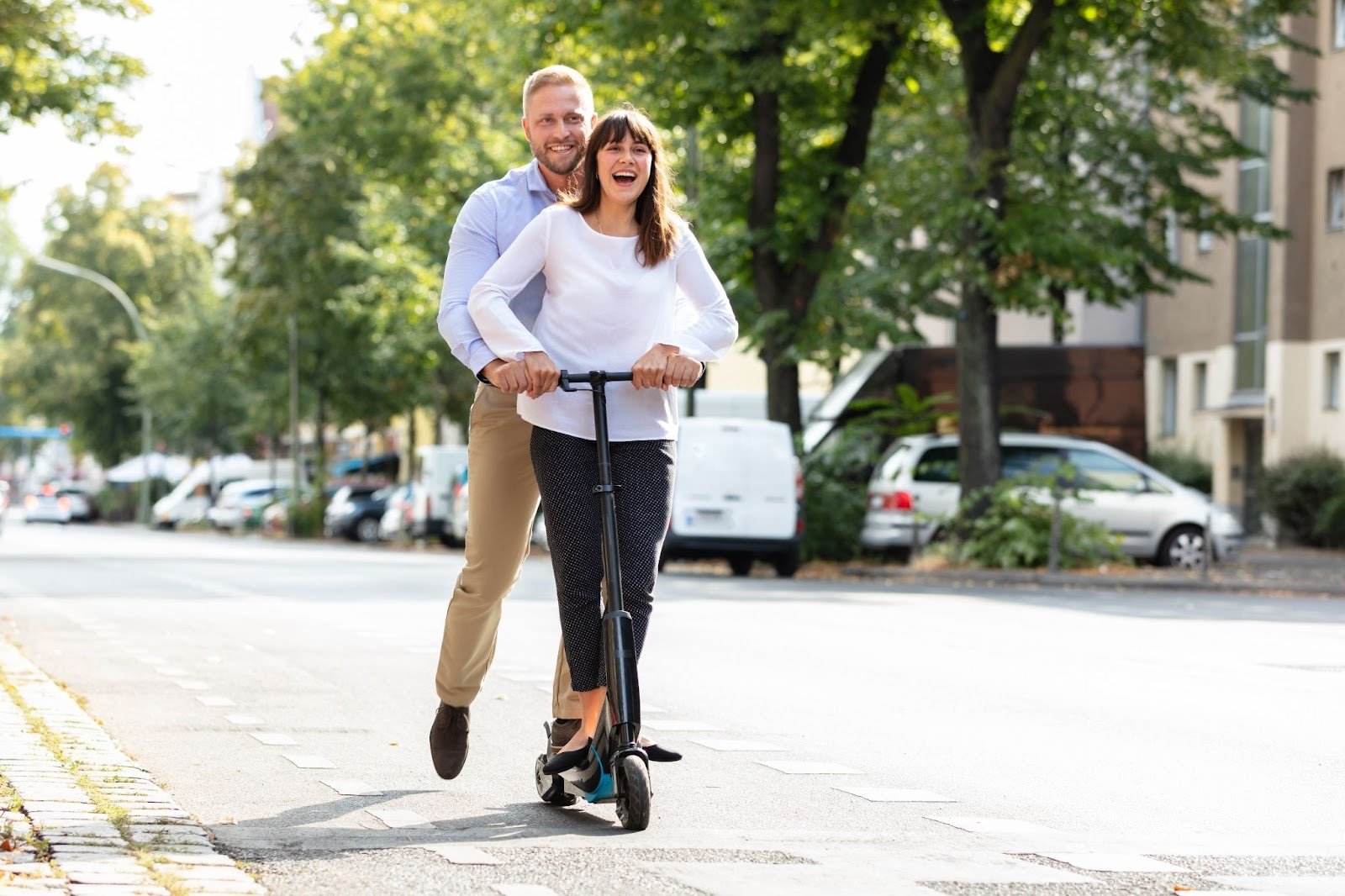
Nope. Tandem riding or carrying goods in a way that makes you take your hands off the handlebars is a big no-no. Both scenarios mess with your handling capabilities, put extra strain on the scooter, and seriously increase the likelihood of accidents.
If you’re thinking about doubling up or hauling stuff, check out our dedicated articles: Can You Carry a Passenger on an Electric Scooter? and Best E-Scooter for Carrying Stuff. We dive deep into why it's not advisable and throw in some tips and alternatives to keep you safe and efficient on the road.
Can you get a DUI charge when riding an e-scooter in San Francisco?
You bet. It's illegal to operate an electric scooter under the influence of alcohol or any drugs, and it can land you a fine of up to $250.
Riding an e-scooter while intoxicated is a recipe for disaster—it messes with your coordination, balance, and reaction time, putting both you and other road users at serious risk.
Do you need insurance or registration for your electric scooter in San Francisco?
No, you are not legally required to have insurance for your electric scooter or register it with the California DMV.
However, even though it's not a legal requirement, having additional insurance coverage is a smart move if you ride a lot for added protection and peace of mind.
Where can you legally ride electric scooters in San Francisco?
The Bay Area boasts miles of bikeways, which are the primary places where regulations encourage and where you’ll want to ride, as they provide the safest environment.
You can also operate e-scooters on streets and highways with speed limits of less than 25 mph. If the speed limit exceeds 25 mph, the street or highway must have a Class II or Class IV bikeway for electric scooters to be permitted.
Where are electric scooters prohibited in San Francisco?
Sidewalks are a definite no-go; riding there is a surefire way to get into trouble with the law. Additionally, electric scooters are not allowed in system facilities or parking structures of public transportation on vehicular crossings, such as bridges (e.g., the Golden Gate Bridge) or other toll roads, unless you have a special permit.
Electric scooters and bikes are also not permitted on the Embarcadero Promenade. In this area, you must use the road or designated bike paths.
Is it legal to ride electric scooters on sidewalks in San Francisco?
No, riding electric scooters on sidewalks is strictly prohibited in San Francisco, except when it's necessary to enter or leave adjacent property. Get caught breaking this rule, and you’re looking at a fine.

To reinforce this, as of September 2023, the city mandated that shared electric scooters must have some form of sidewalk riding detection technology. This tech alerts riders of infractions and deters them from venturing down those forbidden paths.
Can you ride an electric scooter on the road in San Francisco?
Yes, you can ride electric scooters on roads with a speed limit of 25 mph or less. If the road has a speed limit above 25 mph, you are only allowed to ride on it if there's an adjacent Class II or Class IV bikeway where you can ride safely away from car traffic.
For tips on safely riding an electric scooter on the road and the rules you might encounter, check out our article on riding electric scooters on the road.
Speed limits for electric scooters in San Francisco
All electric scooters are required not to exceed 15 mph during operation, regardless of where they are being ridden, whether on a highway or bike lane.
Where should you park your electric scooter in San Francisco?
The best spot to legally park your electric scooter is near the curb, specifically in the street furniture zone. This is the area between the pedestrian walkway and the curb where you find light poles, signposts, and the like. Make sure to park it upright and tidy, ensuring it doesn't block pedestrian traffic on the sidewalks.
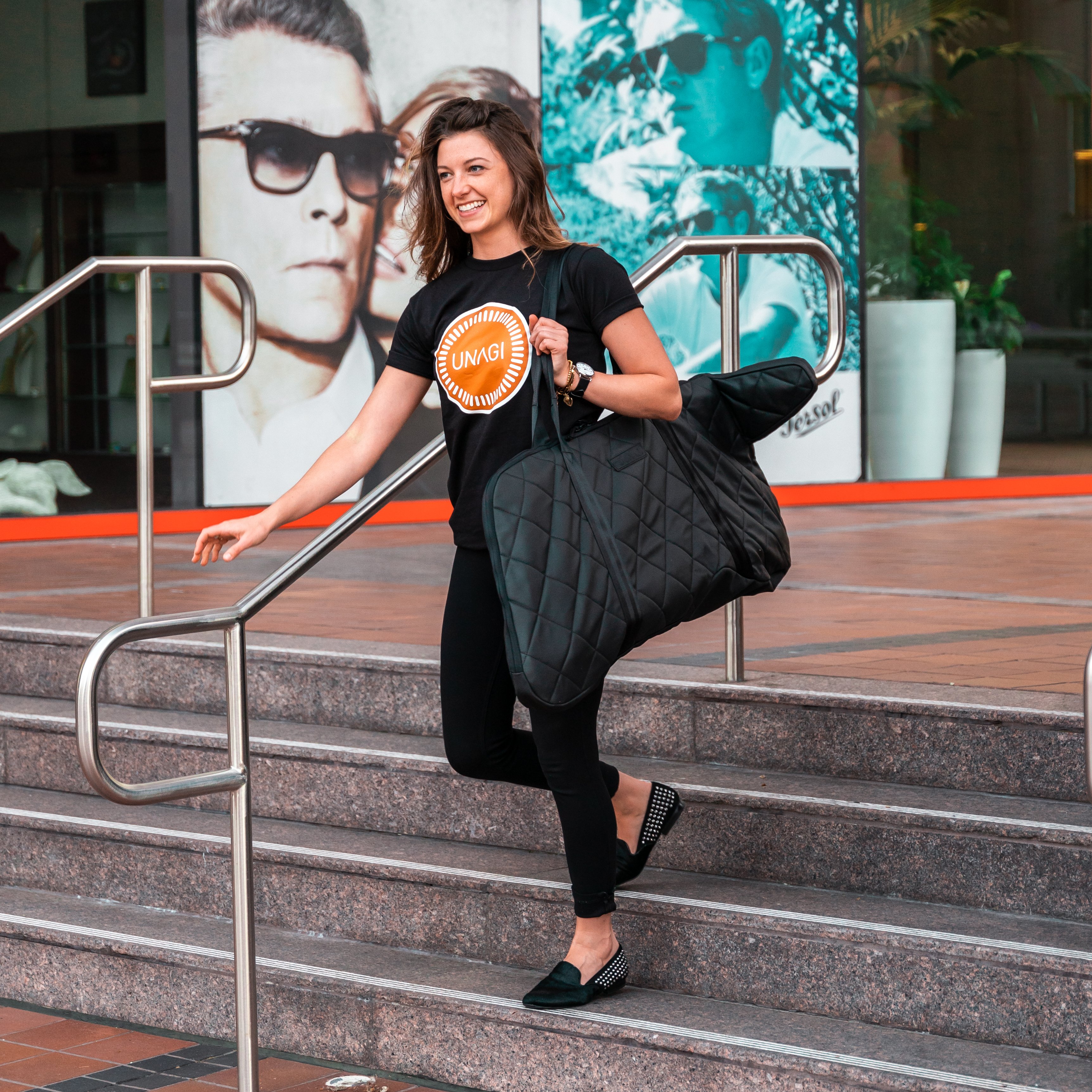
The best practice for private electric scooters is to carry them everywhere you go, like a backpack, if it's convenient. If you must leave your scooter outside, do so only briefly and always lock it securely to a fixed object, preferably a bike rack, using a robust electric scooter lock.
Additionally, companies like BikeLink offer on-demand secure parking services. For a small fee, you can rent individual eLockers to store your electric scooter. To use this service, purchase a BikeLink card for $20, which includes an equivalent amount in rental value.
Parking costs are typically around 5 cents per hour, and you only pay for the time you use, with unused time refunded back to your card. However, while eLockers are generally secure, there have been instances of theft, so carrying your scooter with you remains the best option.
Areas to avoid when parking electric scooters in San Francisco
Parking has been a hot issue, even leading to temporary bans on electric scooters in the past. So, take it seriously. Avoid parking in ways that block pedestrian paths or common sidewalks. Specifically, steer clear of parking:
- On corners and curb ramps
- On narrow sidewalks
- Against buildings
- At transit stops and loading zones
- Near fire hydrants and emergency access points
- In a manner that blocks access points
- In sidewalk amenities and landscaping areas (e.g., seating areas, tree wells)
How to access electric scooters in San Francisco?
There are several different ways to access electric scooters in San Francisco, ranging from rentals to subscriptions and even purchasing your own.
Here’s a quick rundown of your options:
Electric scooter rentals in San Francisco
San Francisco is a scooter-friendly city, giving you plenty of rental options. You’ll find big names like Lime and Spin, as well as local rental shops like Cloud of Goods and Electric Tour Company, which offer unique scooters and different form factors.
The two heavy hitters in the rental scene are Lime and Spin, with a combined fleet of about 5,500 scooters (2,750 each) in the city. Bird was also a significant contributor to this pool, but they closed their San Francisco operations on February 17, 2023, due to compliance difficulties, legal battles with the SMPD, and resulting fines and fees that made it financially challenging to maintain their program in the city.
Rental scooters are perfect for one-off use and are readily available in most parts of the city. However, Spin scooters, in particular, are harder to locate due to their smaller service area, so you’re more likely to spot Lime scooters around.
Lime and Spin scooters are generally tough and built to handle San Francisco’s terrain. But, like any shared ride, frequent use and overdue maintenance mean finding a pristine scooter can be hit-or-miss. At one point, you will definitely come across scooters with loose throttles, half-charged batteries, low tyre pressure, etc.
San Francisco requires scooter companies to have adaptive scooters in their fleets to make things more inclusive. These come with adjustable components, wider bases, seating, and extra wheels to cater to riders with different mobility needs.
And a quick heads-up: using the rental apps can drain your phone battery pretty fast. Always carry a charger with you so you don’t get stranded with a dead phone.
How do you rent an e-scooter in San Francisco?
If you have a smartphone, it is relatively straightforward:
- Download a San Francisco scooter rental app: The first step is to download a scooter-sharing app like Lime or Spin. These apps are available on both iOS and Android platforms. Once downloaded, sign up and add your payment information.
- Locate a scooter: Open the app to see a map of available scooters near you. San Francisco is well-covered, so you should be able to find one nearby. Some apps also allow you to reserve a scooter for a few minutes while you walk to it.
- Unlock the scooter: Once you find a scooter, scan the QR code on the handlebar using the app. This will unlock the scooter and start your ride. Make sure to check the scooter's battery level before unlocking it to ensure it has enough charge for your trip.
- Safety first: Always wear a helmet and be mindful of local traffic laws. San Francisco requires scooter riders to stick to bike lanes and prohibits riding on sidewalks. Be cautious of pedestrians and cars, especially on the city's busy streets. Familiarize yourself with the brakes before heading out, as San Francisco's terrain can be challenging. Keep an eye out for hills and plan your route accordingly.
- Parking the scooter: When you're done with your ride, park the scooter in a designated area. Avoid blocking sidewalks, driveways, or access ramps. Some apps may require you to take a photo of the parked scooter to complete your ride.
- End the Ride: Use the app to end your ride. This will lock the scooter and stop the billing process. To avoid extra charges, make sure you receive a confirmation that your ride has ended.
For those who do not have a smartphone, there is the option of:
- Prepaid cards or accounts that you can purchase from their website or authorized retailers. You can load these cards with credits and use them to unlock and ride scooters without needing a smartphone.
- Customer service assistance: Contact the customer service of the scooter company. Many companies have provisions for users who don't have smartphones.
- Kiosk rentals: In some areas, you might find physical kiosks where you can rent e-scooters.
- Text-based requests: Some scooter companies offer the option to unlock scooters via SMS.
Electric scooter subscription in San Francisco: Ideal for longer-term needs
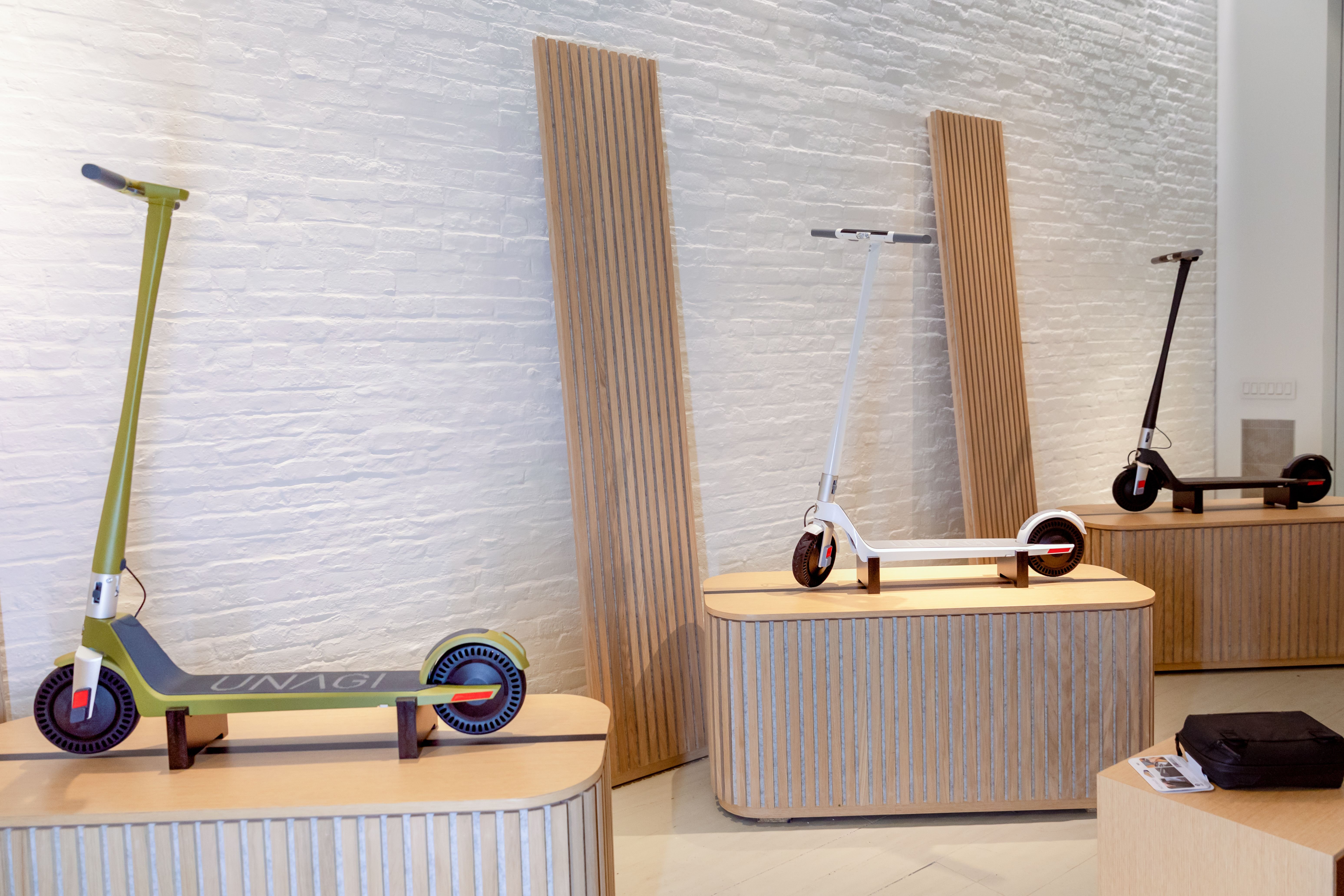
If you need a scooter for an extended period but don’t want to shell out the cash for a new one, an e-scooter subscription might be your best bet.
Subscriptions offer better-performance scooters, consistent availability, and sweet perks like maintenance and insurance. Plus, they’re more hygienic and hassle-free compared to rentals.
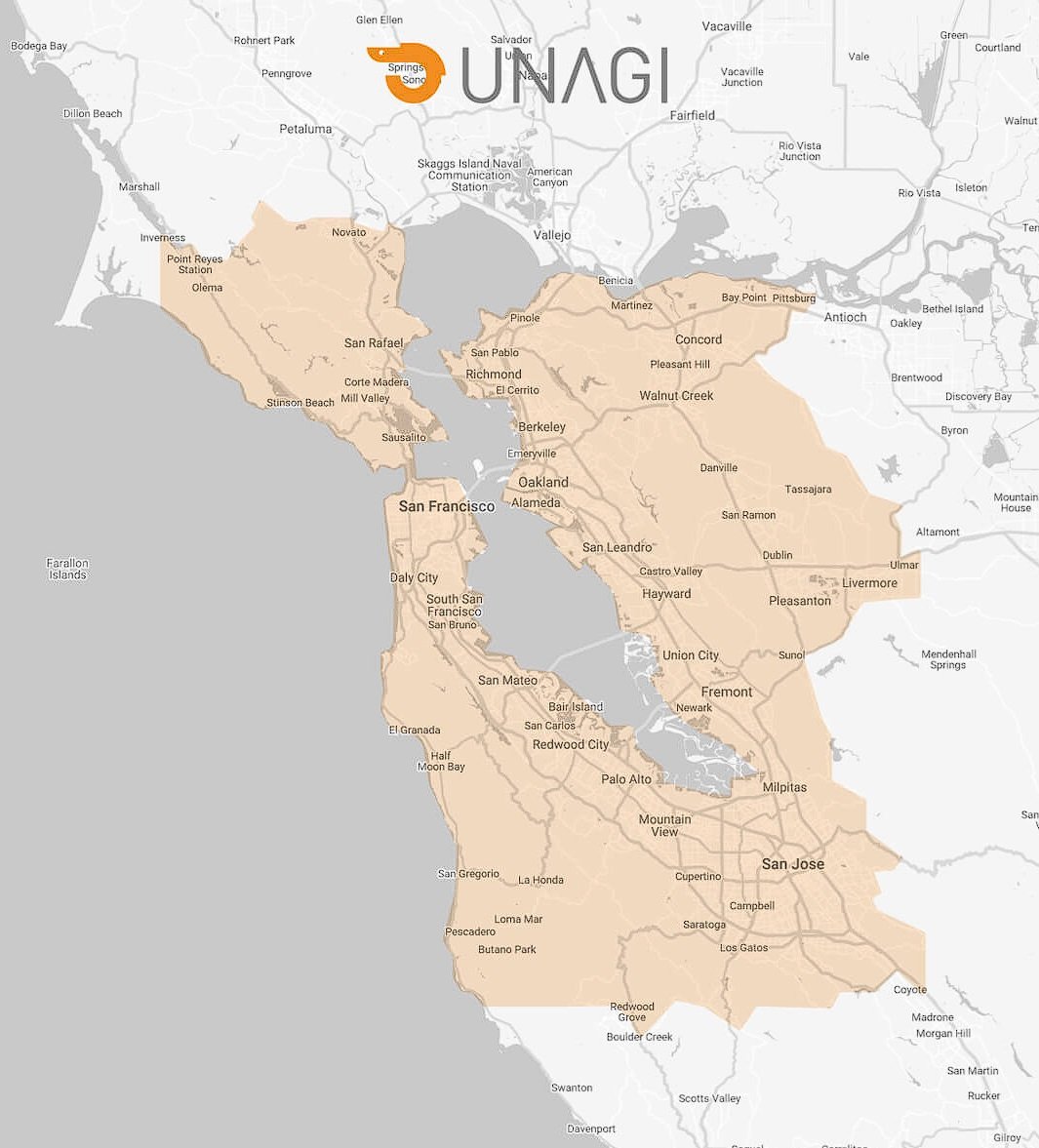
Unagi offers a top-notch subscription program in the Bay Area. It features its lightweight electric scooters, the Model One Classic and the Voyager, which are both perfect for conquering San Francisco’s hilly terrain.
Paul from Rider Guide tested its hill-climbing chops in the Bay Area in his full Unagi Voyager review.
These scooters are not just powerful but also lightweight and portable, weighing less than 30 lbs, making them ideal for commuting. Performance-wise, they leave rental scooters in the dust with dual motors that tackle hills effortlessly and reach top speeds of 20 mph.
They offer a range of 12-25 miles, thanks to UL-certified LG batteries. And even if you run out of juice, the 3-4 hour charging time gets you back on the road in no time.

The subscription costs $59 per month for the Model One Classic and $79 for the Voyager. What's more, Unagi offers discounted rides for longer commitments and college students, making them one of the cheapest electric scooters in San Francisco with dual motors.
The plan includes maintenance, immediate breakdown replacement, and insurance for theft or damage. Plus, your scooter gets delivered to your door via FedEx within 72 hours for free. And guess what? You can cancel the subscription anytime without penalties.
Subscribers also get to join the exclusive Unagi Community, which hosts cool activities in the Bay Area and offers opportunities to connect and share experiences with other riders.
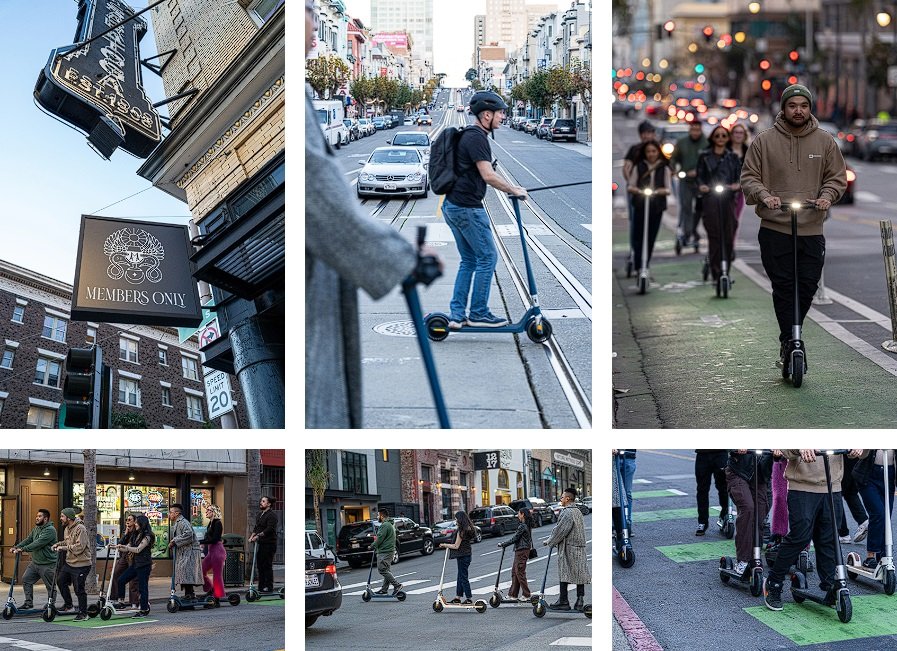
Unagi also organizes monthly group rides in major cities, providing excellent networking opportunities and a chance to explore new places together. Check out the comprehensive yearly calendar for upcoming events across south San Francisco.
Buying an electric scooter in San Francisco
Whether you're a college student or a San Francisco resident, if you're ready to go all-in and want a ride that's always ready, buying an electric scooter is the way to go. This option suits daily commuters and those who want to skip the hassle of rentals. Owning your scooter means you can pick one that perfectly matches your needs, ensuring a consistent and reliable ride every time.
San Francisco has a ton of options, both on-site and online, including reputable dealers like Fluidfreeride, Alien Rides, Voro Motors, and Unagi, which offers both subscription and purchase options. The Unagi Model One Classic goes for $990, and the Voyager for $1,490.
Most of these dealers let you test-ride scooters for free, allowing you to feel each model's weight and performance. You can also get expert advice on what will suit you best. Plus, they provide some of the best warranties and support services around.
Picking the right scooter
When choosing an e-scooter for San Francisco, it's best to go for a dual-motor model to handle the city's occasional hilly terrain. Dual motors come at a higher price, so be prepared to spend $1,000 or more for a good one.
Pro Tip: Test drive your daily commute on a shared scooter and see if it can make it up the inclines of your daily routes and the steepest hills you might encounter. If it can, you might get away with a cheaper powerful single-motor model. If not, you'll want a dual-motor option. Additionally, be sure to check reviews and community feedback, especially on hill-climbing capabilities.
For those with a budget under $400, renting a dual-motor scooter or opting for a subscription might be better than buying a lower-powered single-motor model that will struggle on most trips. Alternatively, wait for promos and holiday seasons when the prices of scooters are significantly reduced.
In summary,
- Scooter Rentals: Great for short-term use, typically for a day, and perfect for short-stay visitors.
- Scooter Subscriptions: Offer a convenient middle ground for regular users. They're cheaper than buying, with 100% availability compared to rental services. They are ideal for long-term visitors and those not yet committed to using e-scooters full-time.
- Buying: Perfect for a resident, daily commuters, and those who have fully embraced the electric scooter lifestyle and have the money to invest in a quality unit.
What are some scenic routes and bike trails for electric scooters in San Francisco?
Here's an overview of some remarkable trails in the San Francisco area, each offering unique experiences and scenic views:
Ferry Building to Golden Gate Bridge-Marin Headlands
This journey offers a comprehensive look at the northern side of San Francisco, starting from the Ferry Building, traversing the Golden Gate Bridge, and ending at the Marin Headlands on the Sausalito side.
A number of safe bicycle trails take you along the waterfront, past many of San Francisco's iconic landmarks, wonderful scenery, and important sites in the area.
The Embarcadero
Starting at the Ferry Building, you'll enjoy views of the San Francisco Bay with its shimmering waters, marine traffic, and ferries. The Bay Bridge, connecting San Francisco to Oakland, looms to the east, while historic piers line your path. Notable ones include Pier 7, Pier 15 (home to the Exploratorium), and the ever-popular Pier 39.
The Ferry Building itself, with its iconic clock tower, is a historic landmark featuring a marketplace. In the distance, you can see Alcatraz Island, the infamous former prison, and on clear days, Angel Island, a state park and historic immigration station, and Treasure Island, located in the middle of the bay.
As you cruise along the Embarcadero, you’ll also encounter various public art installations and sculptures, adding to the visual feast.
Remember, electric scooters aren’t allowed on the Embarcadero Promenade, but the adjacent road and bike lanes still offer a fantastic alternative route.
San Francisco Bay Trail to Marina Boulevard
Continue along The Embarcadero until you reach Fisherman's Wharf. From there, transition to the Bay Trail, heading towards Marina Boulevard through Fort Mason and the Marina Green. This route takes you past several attractions:
- Fisherman's Wharf: Offers views of fishing boats, Alcatraz Island, and the vibrant Pier 39. You'll see sea lions lounging at Pier 39, street performers, and a variety of seafood vendors. The atmosphere is lively, making it a fun place to pass through.
- Fort Mason: A historic former military post now serving as a cultural center with historic buildings, art galleries, and panoramic views of the bay.
- Marina Green: An expansive park with stunning waterfront views of the Golden Gate Bridge, Alcatraz, and the Marin Headlands.
Be aware that The Embarcadero and Fisherman's Wharf can be very crowded, especially on weekends and during tourist season. Riding through pedestrians can be challenging and requires careful navigation.
Crissy Field / Golden Gate Promenade
Follow the Bay Trail through Crissy Field along the Golden Gate Promenade. Crissy Field, a former U.S. Army airfield, has been transformed into a popular recreational area with beaches, picnic areas, and unparalleled views of the Golden Gate Bridge, San Francisco Bay, and the city skyline. It also features a restored tidal marsh, making it a prime spot for bird watching, seasonal wildflowers, and enjoying nature in general.
The promenade is generally wide and can accommodate multiple users, but it’s essential to be mindful of others, especially during peak times when the path can get busy. Some areas of the trail are compacted gravel or dirt paths, which can be challenging to navigate, especially after adverse weather.
Before reaching Crissy Field, you can take a detour to the Palace of Fine Arts, renowned for its classical architecture with a grand rotunda and colonnade set around a tranquil lagoon and gardens, providing a scenic and peaceful environment.
Battery East Trail
As you approach the Golden Gate Bridge, switch to the Battery East Trail. This trail provides a safe route up to the bridge with beautiful views of the structure and the surrounding bay, making it an ideal spot for capturing memorable photos. The section leading up to the Golden Gate Bridge includes some inclines, which may prove challenging for low-powered scooters.
Golden Gate Bridge to Marin Headlands
This short but iconic route lets you experience the majestic Golden Gate Bridge up close. It offers a fantastic viewpoint to appreciate the Bay Area's geography and the bridge’s structure, with panoramic views of the Pacific Ocean, Marin Headlands, and the San Francisco skyline.
The area is filled with old wartime battery locations and military fortifications, making it a great spot for history buffs and photography. If you have the energy and battery, you can even venture even further to Point Bonita Lighthouse.
The path itself is paved and flat, making it easy to navigate. However, electric scooters are not permitted on the sidewalks of the Golden Gate Bridge. Only bicycles and pedestrians are allowed. You will need to park your scooter or walk it across if you want to cross the bridge or just enjoy the view from nearby vantage points.
Challenges
- The areas near the Golden Gate Bridge can be quite windy and foggy, which might affect your ride and limit visibility. The weather can be quite variable, often cool and foggy, especially in the morning and late afternoon. It's advisable to dress in layers.
- As one of San Francisco's most popular tourist attractions, the area can get quite crowded, especially during weekends and holidays. This might affect the enjoyment of those seeking a more solitary experience. Additionally, being a bridge that supports heavy motor vehicle traffic, the area can be quite noisy, which might detract from the tranquil peace some visitors seek.
Golden Gate Park Multi-Use Trail
The Golden Gate Park Multi-Use Trail takes you through the heart of Golden Gate Park, one of the most visited parks in the U.S. This route offers a chance to explore various attractions within the park, such as the California Academy of Sciences, deYoung Museum, Conservatory of Flowers, and the Botanical Gardens.
The trails are generally in good condition and well-maintained, making them easy to navigate.
Challenges:
- As one of the most visited parks, it can get crowded, particularly on weekends and holidays. Some areas might feel too busy, especially around major attractions.
- During peak times, finding parking can be challenging
Presidio Promenade Trail
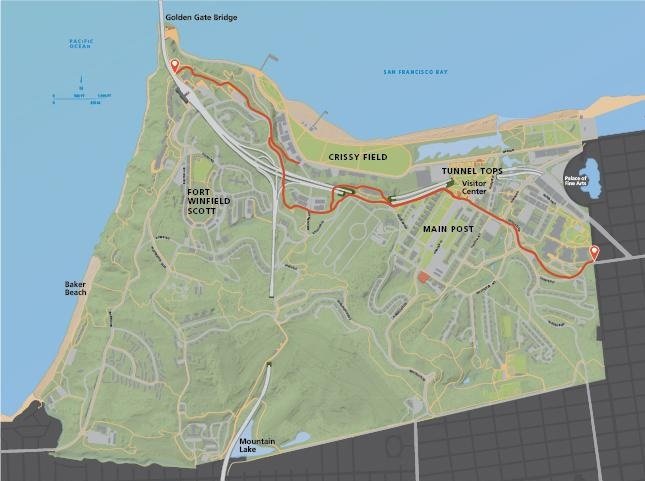
The Presidio has been a part of San Francisco's history for nearly 150 years and now serves as a national park with accessible trails and beautiful vistas. The trail begins at the Lombard Gate, located at the northeastern edge of the Presidio. From there, the trail winds through various parts of the Presidio, including significant historical and natural areas.
As you ride, you'll pass through the Main Post, the historic and cultural heart of the Presidio. Here, you can check out:
- Presidio Officers' Club: Features historical and cultural exhibits.
- Walt Disney Family Museum: Dedicated to the life and legacy of Walt Disney, featuring exhibits on his life, career, and the history of the Disney company.
The trail continues, winding past significant sites like the San Francisco National Cemetery, a historic military cemetery, restored buildings, and old military installations like Battery East.
It continues through lush forests, landscaped gardens, and open meadows, providing stunning views of the San Francisco Bay and the Golden Gate Bridge. The trail concludes near the Golden Gate Bridge, providing access to viewpoints and connecting with other trails such as the Golden Gate Promenade and the Battery East Trail.
Challenges:
- Potentially confusing route: The trail's signage is sometimes lacking, leading to confusion and difficulty in navigation. The intertwining of paths with urban streets can detract from the experience for those expecting a straightforward ride.
- Most of the trail is paved and easy to ride, but some sections involve moderate slopes or are less well-maintained, which can be challenging, especially after bad weather.
- Like many attractions in San Francisco, the Presidio Promenade can become quite crowded, particularly during weekends and holidays.
- The proximity to city streets and the occasional noise from traffic can somewhat diminish the natural tranquility expected from park trails.
Twin Peaks
This trail leads to one of the highest points in San Francisco and offers a panoramic view of the entire city. While the climb to the top might be challenging for underpowered scooters, the paths are well-maintained and scooter-friendly, making the ascent an achievable feat.
Good aspects:
- Spectacular views: From the peaks, riders can enjoy a stunning 360-degree view of the San Francisco cityscape, making it an ideal spot for photography and sightseeing.
- Accessibility: The trail is easily accessible from different parts of the city and offers paved roads up to the top.
Challenges:
- Foggy conditions: The trail often experiences foggy conditions, especially after mid-morning, which can obscure the scenic views and cause temperatures to drop unexpectedly.
- Active roadways: Some parts of the trail involve active roadways, which can pose safety risks.
- Hilly terrain: The trail is hilly, which might be an issue for underpowered scooters.
- Dirt paths and stairs: While mostly paved, the trail includes some dirt paths and staircases that are not in the best condition. These sections can be challenging, especially when carrying a scooter, and may be best avoided. For those who prefer a less strenuous experience, the views from the lower levels of the trail are still impressive and well worth the ride.
Lake Merced Trail
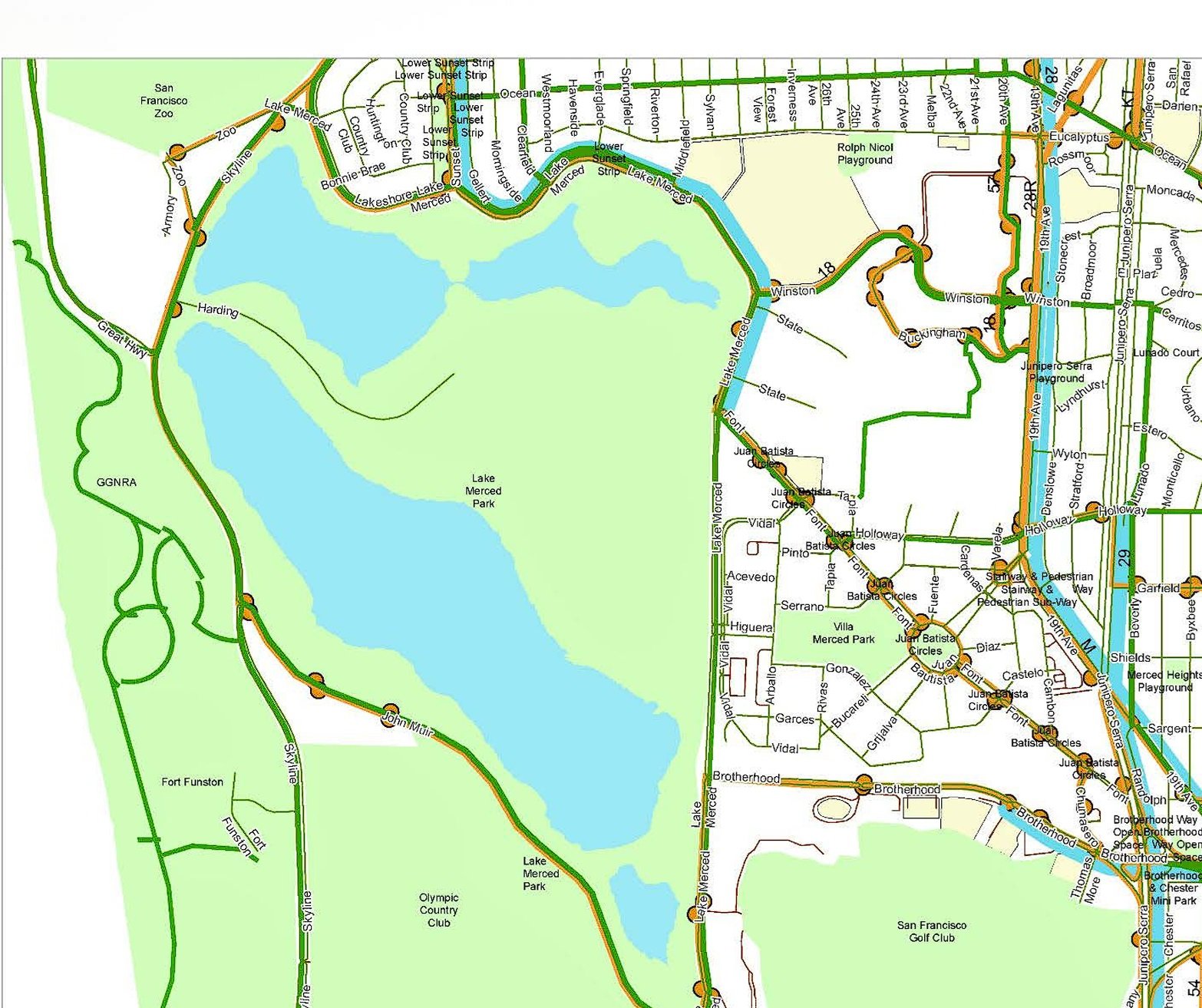
This paved loop offers beautiful views of Lake Merced and is relatively quiet and less crowded compared to more central urban parks, making it a serene place for a scooter ride. The loop around the lake is perfect for a leisurely ride, offering peaceful water views and a chance to connect with nature.
Good aspects:
- Scenic views: The loop offers picturesque views of Lake Merced, ideal for a tranquil and leisurely ride.
- Bird watching: The trail is a great spot for bird watchers, with an abundance of birdlife thriving in the wooded areas and the lake itself.
- Amenities: Along the route, riders will find amenities such as picnic areas and benches, perfect for taking a break and soaking in the serene surroundings.
Challenges:
- Highway proximity: Some sections of the trail run alongside a highway, which can detract from the natural ambiance.
- Narrow paths
San Francisco Zoo to Golden Gate Bridge (Great Highway Trail and Land End Trail)
This route is relatively tough and long, especially towards the last stretch, as some sections are unridable due to the terrain, inclines, stairs, and nature of the road. Be prepared to either carry your scooter along some sections or find a safe way to store or lock it as you explore some inaccessible areas.
Starting point: San Francisco Zoo
Located at Sloat Boulevard and the Great Highway, the San Francisco Zoo features over 1,000 exotic, endangered, and rescued animals in large, naturalistic settings, along with beautiful botanical gardens.
Great Highway Trail

Source:https://www.sfmta.com/projects/great-highway-pilot-evaluation-project
From the San Francisco Zoo, head north on the Great Highway Trail, which runs parallel to the Great Highway. The trail is especially popular among cyclists and scooter riders, particularly on weekends when parts of the Great Highway are closed to car traffic, creating a safe and spacious path. The trail is wide, flat, and paved, making for an easy and comfy ride with killer views of the Pacific Ocean the whole way.
Challenges:
- The trail's proximity to the beach means that it can be quite windy, and sand may blow onto the path, which can be problematic for riders.
- The natural setting doesn't offer much shade or amenities along certain parts of the trail, which could be a drawback during warmer months or if you need regular rest stops.
On the trail, you’ll pass by:
- Ocean Beach: A long stretch of sandy beach running alongside the Great Highway. Popular for walking, jogging, beachcombing, surfing, and picnicking. You’ll enjoy the fresh sea air and beautiful ocean views.
- Golden Gate Park: At Lincoln Way, you can take a detour into Golden Gate Park via its western edge. This expansive park features attractions like the Dutch Windmill, Queen Wilhelmina Tulip Garden, and numerous trails (Refer to the Golden Gate Park Multi-Use Trail section for more details.)
Exit Golden Gate Park and continue north on the Great Highway Trail.
Sutro Baths
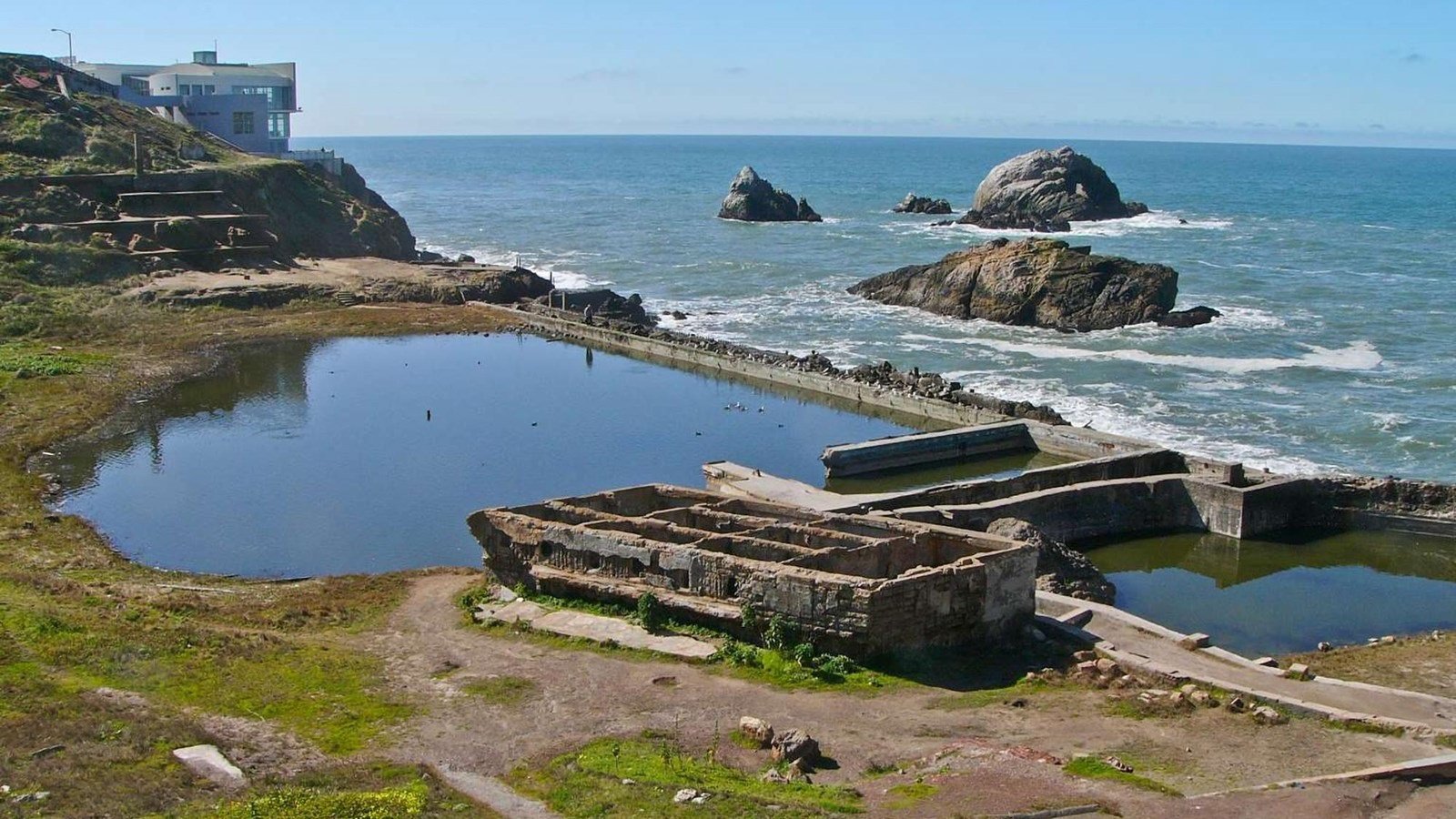
Source:https://www.nps.gov/places/000/sutro-baths.htm
At Point Lobos Avenue, make a short detour to visit the Sutro Baths. The Sutro Baths were once a large, privately owned swimming pool complex that closed in 1966. Today, they are a popular spot that offers a unique and eerie experience, with opportunities to capture beautiful photographs, especially of the rugged coastline, rock formations, and the ocean itself. The location is also popular for romantic sunset views and stargazing.
Challenges:
- It gets very windy, so riders should be prepared for potentially chilly and gusty weather.
- The hike down to the ruins can be strenuous, with lots of steps, dirt roads, and uneven terrain, making it impossible to go on a scooter.
Lands End Trail
From the Sutro Baths, use the Sutro Bath upper trail to connect to the coastal Lands End Trail. This popular hiking trail winds along the coast, offering stunning vistas of the Pacific Ocean, the Golden Gate Bridge, and the Marin Headlands. It's also known for its diverse flora and fauna and is a great spot for bird watching. The trail is generally well-maintained, with clear signage, and in good condition.
Challenges:
- The trail is a mix of paved and dirt paths, primarily designed for walking. There are sections with flights of stairs and narrow paths, making it impossible to ride a scooter. You will need to dismount and walk your scooters on several sections of the trail.
- The terrain is quite hilly, adding to the difficulty.
- The area is also known for its windy conditions, especially near the ocean, and can become crowded during peak times.
This trail is really for experienced riders with good off-road electric scooters, but even then, carrying them on some sections can be a real challenge. It's recommended to use nearby roads such as El Camino Del Mar and Lincoln Highway, which offer easier riding conditions and still provide beautiful views.
You can then pass by Baker Beach, located east of Lands End, where you'll get even more views of the Pacific Ocean and the Golden Gate Bridge. Afterward, head back to Lincoln Boulevard and continue north towards the bridge itself.
Conclusion: Best Scooter for San Francisco?
So the question stands: What type of electric scooter do you need for San Francisco?
Let’s break it down.
San Francisco is one of the hilliest cities in the USA and while there are some famously steep streets, the majority of bike paths you’ll regularly traverse have more moderate grades, typically below 10%.
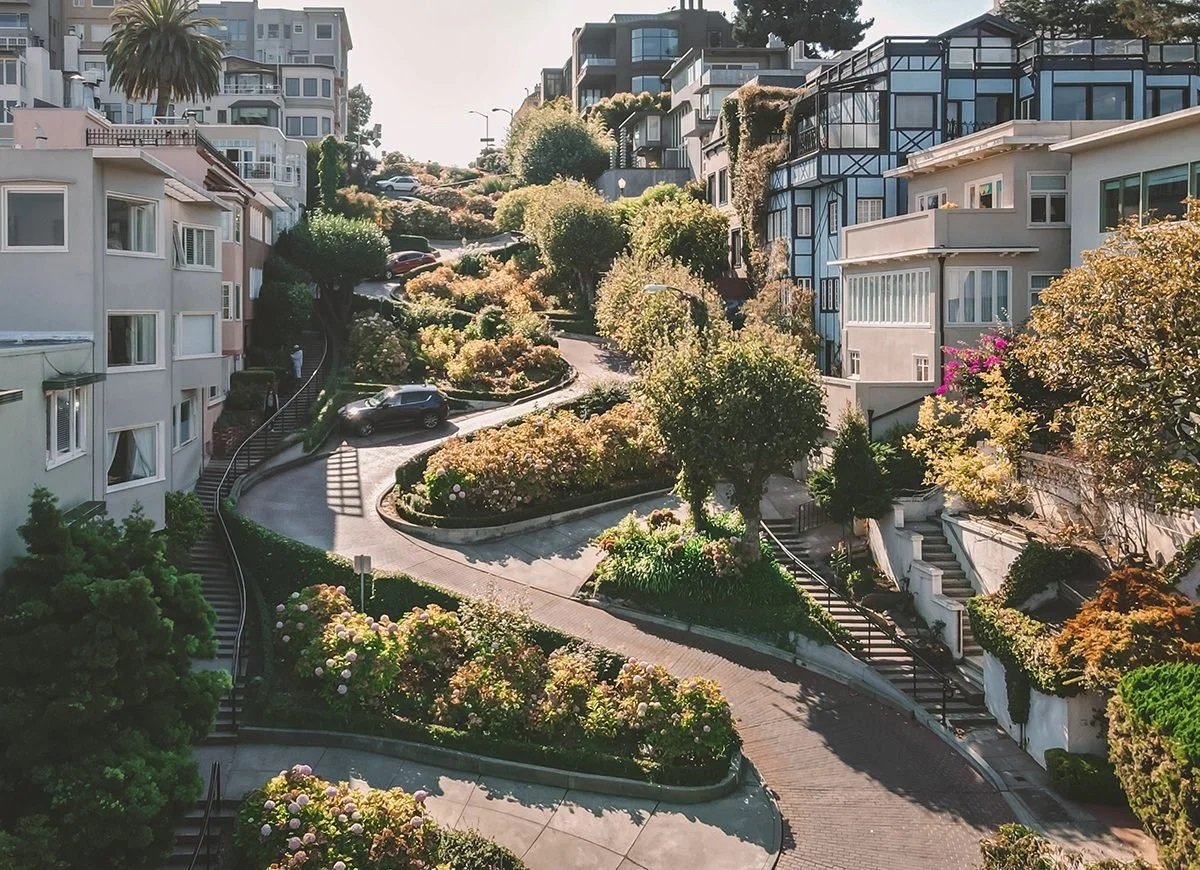
Plenty of scooters can handle these 10% grade hills, depending on your weight and how much speed loss you're willing to accept on the ascents. But to tackle steeper hills at a quicker and easier pace, you'll need a scooter that:
Has dual motors: not to knock single motors, but dual motors are just better for hill climbing. Sure, some powerful single-motor scooters can handle the hills, but you might experience a lot of wheel spin and potentially strain the motor. Dual motors distribute the power between the wheels, making it less strenuous on the motors and much smoother.
Similar results can be expected if you go off-road; dual motors are significantly better.
Anything rated over 2000W will conquer any hill effortlessly; just hold on tight to those handlebars. Scooters with 1000W on each motor will also manage going up steep hills but at a slower speed. At the lower end, you have commuter scooters under 500W, which will struggle or even stop on steeper hills. They are better suited to grades below 10%.
For the Bay Area’s topography, 500W should be your minimum, and if you’re heavier, aim for 1000W or more. The 350W entry e-scooters will struggle on many of the hills; however, it depends on the manufacturer and make, as some may perform significantly better than others even if the stated spec-numbers are similar. It has to do with the controllers, motors design, and peak power.
But all in all, the higher-wattage scooters with dual motors will perform better.
Also, check out our article How to Ride an Electric Scooter Uphill? 5 Techniques for Steep Inclines for more tips on making your scooter more efficient on hills.
Wheels with good traction: Wider, bigger tires with deeper treads provide better grip and traction, reducing the wheel slip you might experience when taking on steep hills.
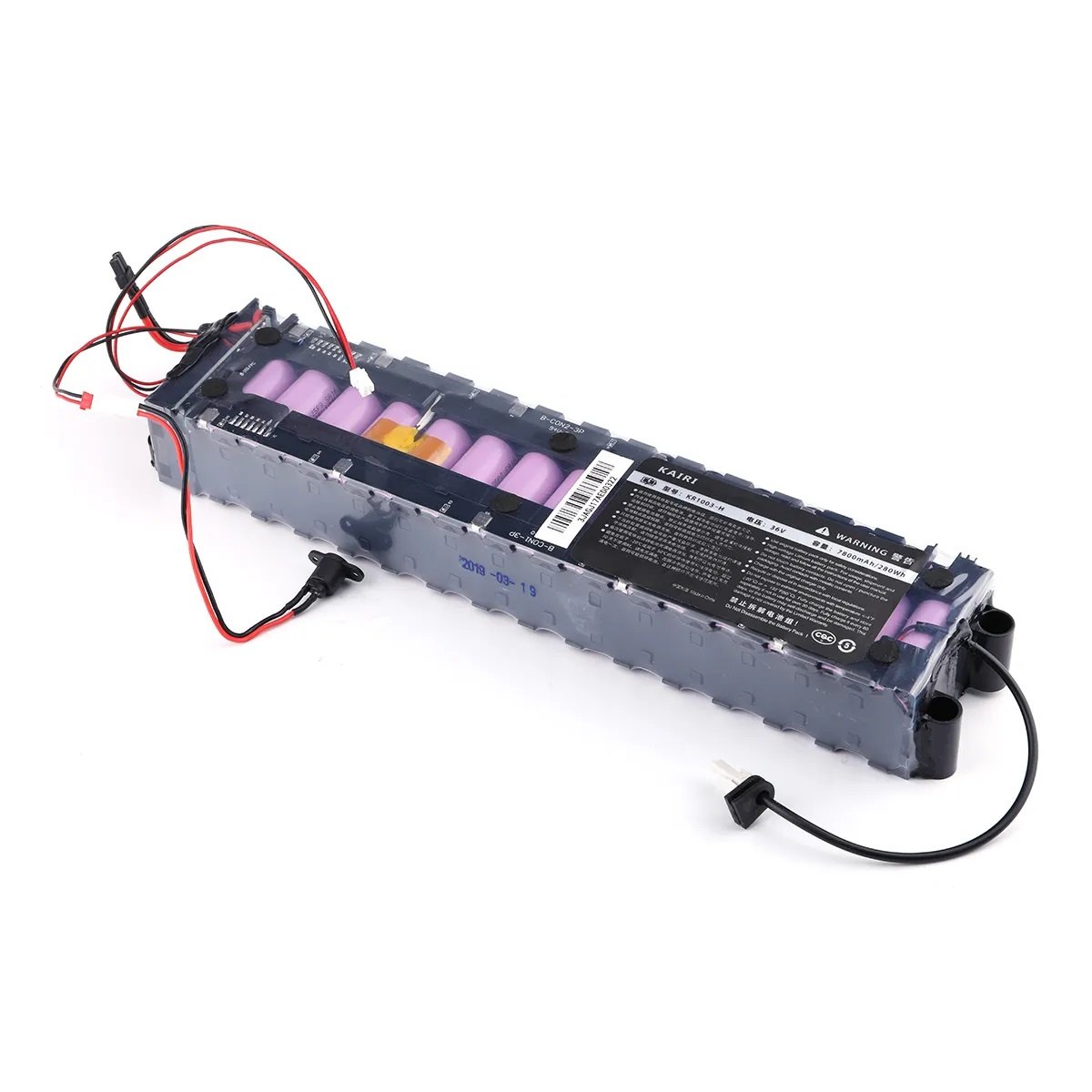
Ample battery capacity: Climbing hills takes a lot of juice. You need a scooter with a big battery that won’t drain quickly on those climbs. A larger battery not only allows you to go farther on a single charge but also provides sustained power for uphill climbs.
Great brakes: Every scooter needs good brakes, but for San Francisco’s hills, you need effective, non-grabby brakes to handle those downhill stretches safely.
Best Overall Scooter for San Francisco
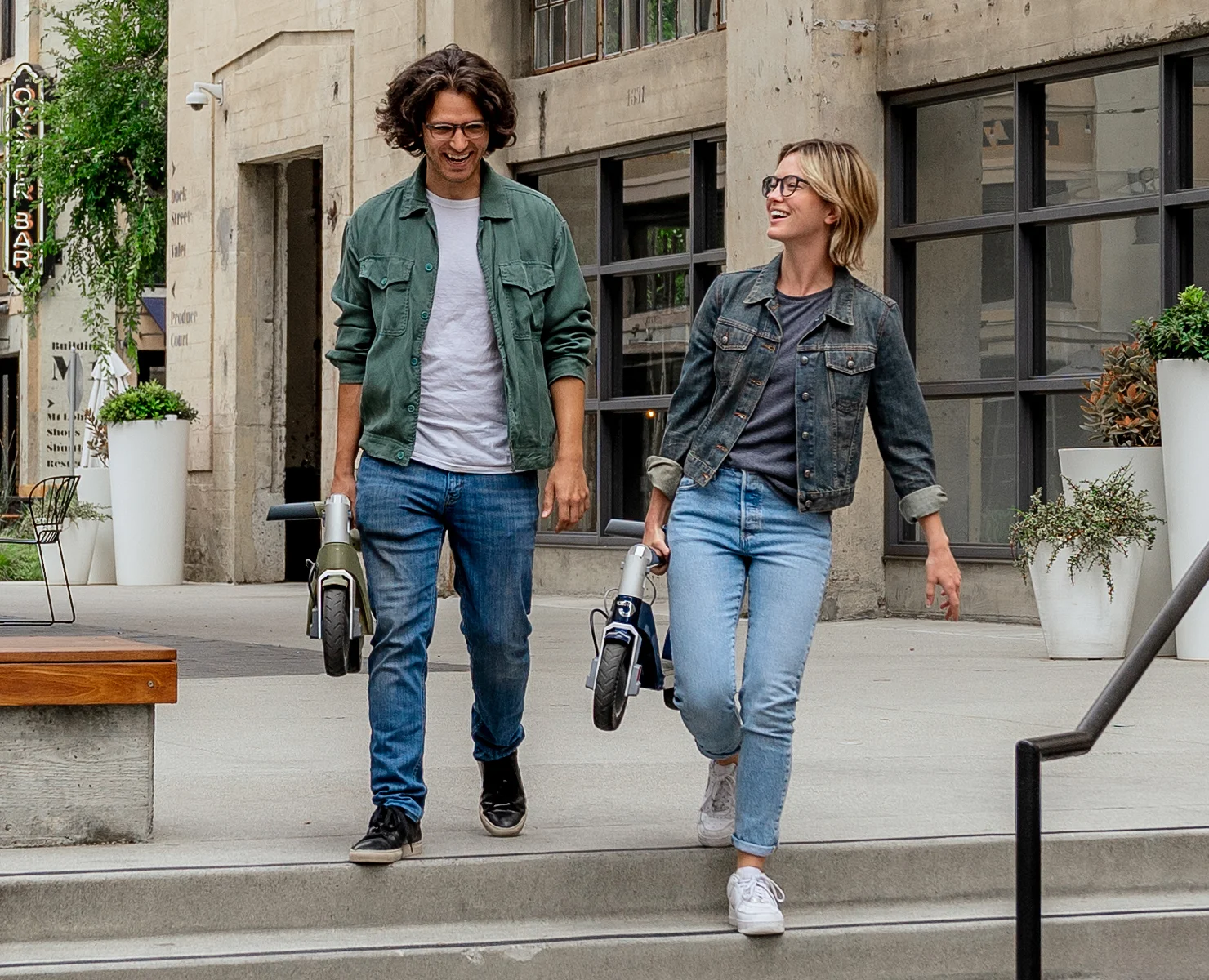
All in all, the best electric scooter for San Francisco is one that can effortlessly handle steep hills, which requires a model with strong motors, preferably dual motors, good traction, effective brakes, and ample battery capacity for extended performance. High-wattage scooters like anything from our fastest electric scooters list—the NAMIs, Kaabos, and Minimotors—will do, but they come with a big caveat: weight, often tipping the scales at over 100 lbs.
This added weight and lack of portability can be a significant issue if your commute involves intermodal transportation or if you need to carry your scooter frequently. If you don’t have to carry it often and it's your primary mode of daily commute or just for weekend fun, then go ahead and splurge on a powerful dual-motor scooter that will climb hills perfectly.
Just remember, the speed limit for electric scooters in San Francisco is capped at 15 mph in public spaces so you may not fully utilize the top speed of performance scooters. Speed enforcement is pretty lax at the moment, but you never know when they might decide to crack down.
Best lightweight scooter for San Francisco
For a daily commuter, the challenge lies in finding a powerful yet lightweight dual-motor scooter that can handle the occasional hilly terrain. Most lightweight scooters are either single-motor or underpowered to cut costs and weight. However, the Unagi Voyager fits the bill perfectly.
The Unagi Voyager is practical for daily commutes involving intermodal transport and frequent carrying, as it weighs only 29.6 lbs (13.4 kg). It has dual motors with a peak power of 1000W, which can tackle most hills.
Tip: No need to buy upfront—test it out with a one-month subscription to see if it meets your needs.
The Unagi Voyager also has a 20 mph top speed, which can be further reduced using the available ride modes, making it perfect for San Francisco’s 15 mph speed limit. You won’t easily break the law, and it’s a safe speed for maneuvering through the crowded streets of San Francisco.
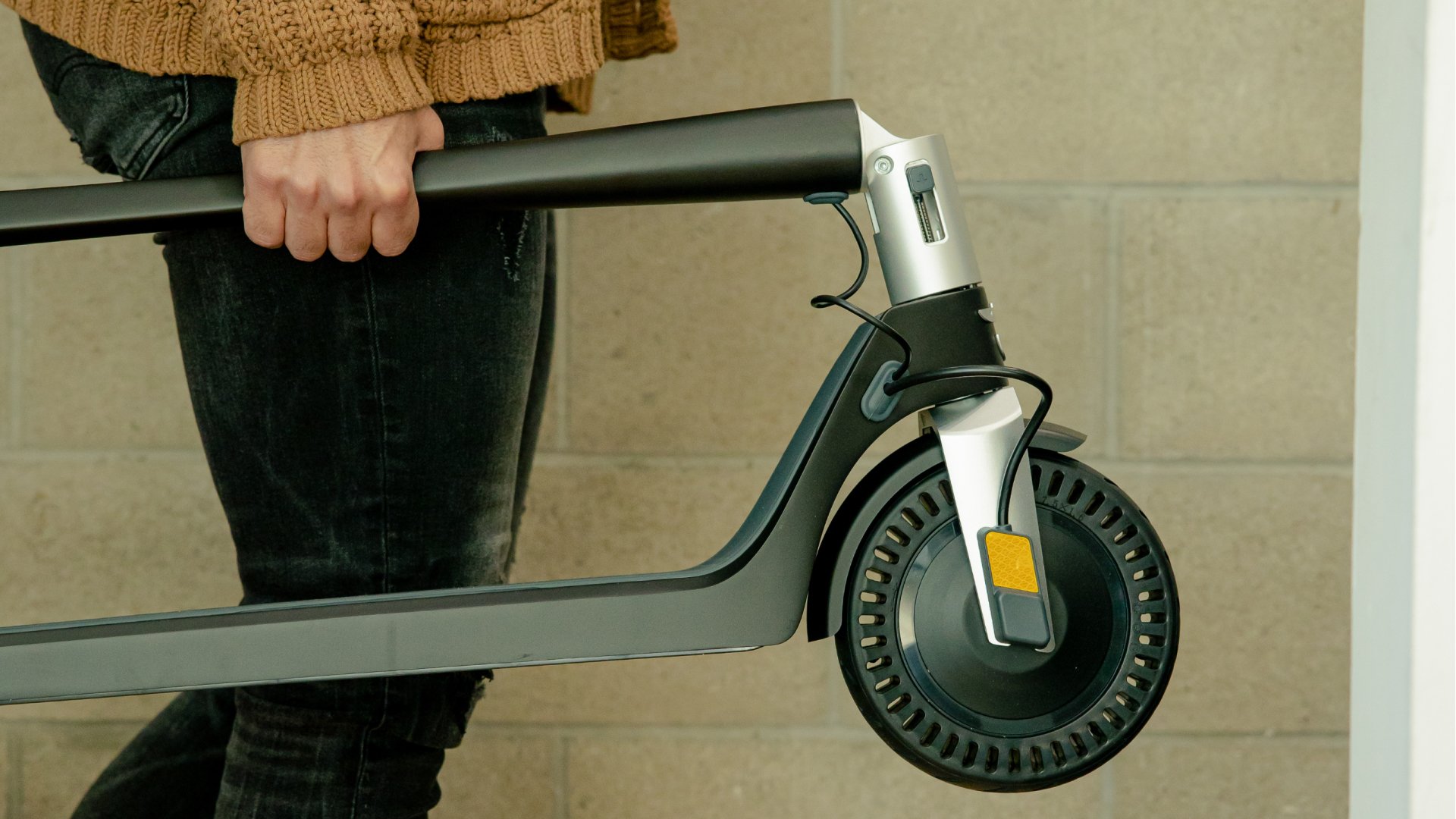
To summarize: the best electric scooter for San Francisco depends on your specific needs. If you weigh over 220 lbs, use the scooter for your entire journey, don’t need to lift it much, don’t prioritize portability, and have the cash, go for the high-performance models. But remember the speed limit caveat in San Francisco.
For the best lightweight electric scooter that can tackle most terrain and is portable enough for daily commuting, the UNAGI Voyager is an ideal choice for the Bay Area.

Stay current with the latest U.S. electric scooter laws in our 2025 guide. Updated annually since our first comprehensive guide, ensuring you have the most recent state and city regulations to ride responsibly”

The Slack Core 920R is currently the fastest electric scooter in 2025 that you can purchase without the need for pre-order.

Our selection of the best electric scooters 2025 spans the fastest e-scooters to the most portable ones, the ones designed for city riding and off-road, the best scooters for rain, budget electric scooters for students, and more powerful ones for skilled riders.

The Unagi Voyager is the best lightweight electric scooter for adults and teenagers. It is the ultraportable sequel to its predecessor, the Unagi Model One Classic.

If you're wondering whether an electric scooter with a seat is right for you, this is a detailed article that would suit your need.

Understand which personal electric vehicle is best, the choice between an electric bike or electric scooter might already be made for you by some critical factors, including portability and storage capacity.

In the U.S., most states don't require a license. For those that do, they usually just ask for a regular driver's license or a learner's permit.

Yes, you can bring an electric scooter on a plane, but it needs to have a lithium battery smaller than 100 watt-hours, which most don't.

Manufacturers advise against riding electric scooters in the rain. The main reasons are: water can fry the electronics, make the ride dangerous, and void your warranty.

The basis and the premise of my work is that we either operate out of love or we operate out of fear...Time is currency. The coolest thing about the scooters is that it's really quick, and it goes uphill. From there, traveling more efficiently and having a good time doing it--I think that's the most important thing.

Cynthia Leu has a full plate. A tech worker by day, Cynthia spends her off time balancing the parallel lives of a powerlifter, entrepreneur, mental health advocate, and more. Riding Unagi helps this USMC veteran cut down on everyday…

https://www.youtube.com/watch?v=7m2hVBE62LY Rasheed Muhammad is sick of Los Angeles traffic. In order to preserve his sanity, Rasheed has traded his everyday driving habit for the portable and beautiful Unagi Model One. It’s an essential accessory for navigating LA streets -- and…

Rich Lee, Co-Founder of San Francisco’s SPRO Coffee Lab, wants to share his love for coffee with the world. He depends on riding Unagi to avoid the hassle of navigating the parking crunch in the booming Mission Bay neighborhood.…















